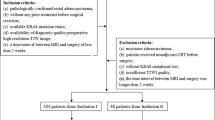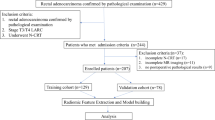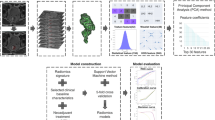Abstract
Objectives
To develop and validate radiomic models in evaluating biological characteristics of rectal cancer based on multiparametric magnetic resonance imaging (MP-MRI).
Methods
This study consisted of 345 patients with rectal cancer who underwent MP-MRI. We focused on evaluating five postoperative confirmed characteristics: lymph node (LN) metastasis, tumor differentiation, fraction of Ki-67-positive tumor cells, human epidermal growth factor receptor 2 (HER-2), and KRAS-2 gene mutation status. Data from 197 patients were used to develop the biological characteristics evaluation models. Radiomic features were extracted from MP-MRI and then refined for reproducibility and redundancy. The refined features were investigated for usefulness in building radiomic signatures by using two feature-ranking methods (MRMR and WLCX) and three classifiers (RF, SVM, and LASSO). Multivariable logistic regression was used to build an integrated evaluation model combining radiomic signatures and clinical characteristics. The performance was evaluated using an independent validation dataset comprising 148 patients.
Results
The MRMR and LASSO regression produced the best-performing radiomic signatures for evaluating HER-2, LN metastasis, tumor differentiation, and KRAS-2 gene status, with AUC values of 0.696 (95% CI, 0.610–0.782), 0.677 (95% CI, 0.591–0.763), 0.720 (95% CI, 0.621–0.819), and 0.651 (95% CI, 0.539–0.763), respectively. The best-performing signatures for evaluating Ki-67 produced an AUC value of 0.699 (95% CI, 0.611–0.786), and it was developed by WLCX and RF algorithm. The integrated evaluation model incorporating radiomic signature and MRI-reported LN status had improved AUC of 0.697 (95% CI, 0.612–0.781).
Conclusion
Radiomic signatures based on MP-MRI have potential to noninvasively evaluate the biological characteristics of rectal cancer.
Key Points
• Radiomic features were extracted from MP-MRI images of the rectal tumor.
• The proposed radiomic signatures demonstrated discrimination ability in identifying the histopathological, immunohistochemical, and genetic characteristics of rectal cancer.
• All MRI sequences were important and could provide complementary information in radiomic analysis.


Similar content being viewed by others
Abbreviations
- AUC:
-
Area under the receiver operating characteristic curve
- CRC:
-
Colorectal cancer
- DCE:
-
Dynamic contrast-enhanced
- DWI:
-
Diffusion-weighted imaging
- HER-2:
-
Human epidermal growth factor receptor 2
- LASSO:
-
Least absolute shrinkage and selection operator
- MP-MRI:
-
Multiparametric magnetic resonance imaging
- MRMR:
-
Minimum redundancy maximum relevance
- RF:
-
Random forest
- WLCX:
-
Wilcoxon rank-sum test
References
Siegel RL, Miller KD, Jemal A (2017) Cancer statistics, 2017. CA Cancer J Clin 67:7–30
Siegel RL, Miller KD, Fedewa SA et al (2017) Colorectal cancer statistics, 2017. CA Cancer J Clin 67:177–193
Van Cutsem E, Kohne CH, Hitre E et al (2009) Cetuximab and chemotherapy as initial treatment for metastatic colorectal cancer. N Engl J Med 360:1408–1417
Heinemann V, von Weikersthal LF, Decker T et al (2014) FOLFIRI plus cetuximab versus FOLFIRI plus bevacizumab as first-line treatment for patients with metastatic colorectal cancer (FIRE-3): a randomised, open-label, phase 3 trial. Lancet Oncol 15:1065–1075
Van Cutsem E, Kohne CH, Lang I et al (2011) Cetuximab plus irinotecan, fluorouracil, and Leucovorin as first-line treatment for metastatic colorectal cancer: updated analysis of overall survival according to tumor KRAS and BRAF mutation status. J Clin Oncol 29:2011–2019
Martin V, Landi L, Molinari F et al (2013) HER2 gene copy number status may influence clinical efficacy to anti-EGFR monoclonal antibodies in metastatic colorectal cancer patients. Br J Cancer 108:668–675
Brown DC, Gatter KC (2002) Ki67 protein: the immaculate deception? Histopathology 40:2–11
Shah MA, Renfro LA, Allegra CJ et al (2016) Impact of patient factors on recurrence risk and time dependency of oxaliplatin benefit in patients with colon cancer: analysis from modern-era adjuvant studies in the Adjuvant Colon Cancer End Points (ACCENT) Database. J Clin Oncol 34:843-+
Xiao H, Yoon YS, Hong SM et al (2013) Poorly differentiated colorectal cancers correlation of microsatellite instability with clinicopathologic features and survival. Am J Clin Pathol 140:341–347
Burrell RA, McGranahan N, Bartek J, Swanton C (2013) The causes and consequences of genetic heterogeneity in cancer evolution. Nature 501:338–345
Robertson EG, Baxter G (2011) Tumour seeding following percutaneous needle biopsy: the real story! Clin Radiol 66:1007–1014
Lambin P, Rios-Velazquez E, Leijenaar R et al (2012) Radiomics: extracting more information from medical images using advanced feature analysis. Eur J Cancer 48:441–446
Jhaveri KS, Hosseini-Nik H (2015) MRI of rectal cancer: an overview and update on recent advances. AJR Am J Roentgenol 205:W42–W55
Dinapoli N, Casa C, Barbaro B et al (2016) Radiomics for rectal cancer. Translational Cancer Research 5:424–431
Gillies RJ, Kinahan PE, Hricak H (2016) Radiomics: images are more than pictures, they are data. Radiology 278:563–577
Huang YQ, Liang CH, He L et al (2016) Development and validation of a radiomics nomogram for preoperative prediction of lymph node metastasis in colorectal cancer. J Clin Oncol 34:2157−+
Nie K, Shi LM, Chen Q et al (2016) Rectal cancer: assessment of neoadjuvant chemoradiation outcome based on radiomics of multiparametric MRI. Clin Cancer Res 22:5256–5264
Liu ZY, Zhang XY, Shi YJ et al (2017) Radiomics analysis for evaluation of pathological complete response to neoadjuvant chemoradiotherapy in locally advanced rectal cancer. Clin Cancer Res 23:7253–7262
Yankai M, Yuchen Z, Di D et al (2018) Novel radiomic signature as a prognostic biomarker for locally advanced rectal cancer. J Magn Reson Imaging. https://doi.org/10.1002/jmri.25968
Liang CS, Huang YQ, He L et al (2016) The development and validation of a CT-based radiomics signature for the preoperative discrimination of stage I-II and stage III-IV colorectal cancer. Oncotarget 7:31401–31412
Fluge O, Gravdal K, Carlsen E et al (2009) Expression of EZH2 and Ki-67 in colorectal cancer and associations with treatment response and prognosis. Br J Cancer 101:1282–1289
Xia W, Gao X (2014) A fast deformable registration method for 4D lung CT in hybrid framework. Int J Comput Assist Radiol Surg 9:523–533
Vallieres M, Freeman CR, Skamene SR, El Naqa I (2015) A radiomics model from joint FDG-PET and MRI texture features for the prediction of lung metastases in soft-tissue sarcomas of the extremities. Phys Med Biol 60:5471–5496
Xia W, Chen Y, Zhang R et al (2018) Radiogenomics of hepatocellular carcinoma: multiregion analysis-based identification of prognostic imaging biomarkers by integrating gene data-a preliminary study. Phys Med Biol. https://doi.org/10.1088/1361-6560/aaa609
Aerts HJWL, Velazquez ER, Leijenaar RTH et al (2014) Decoding tumour phenotype by noninvasive imaging using a quantitative radiomics approach. Nat Commun. https://doi.org/10.1038/ncomms5006
Parmar C, Grossmann P, Bussink J, Lambin P, Aerts HJWL (2015) Machine learning methods for quantitative radiomic biomarkers. Sci Rep. https://doi.org/10.1038/srep13087
Peng HC, Long FH, Ding C (2005) Feature selection based on mutual information: criteria of max-dependency, max-relevance, and min-redundancy. IEEE Trans Pattern Anal Mach Intell 27:1226–1238
Parmar C, Grossmann P, Rietveld D, Rietbergen MM, Lambin P, Aerts HJWL (2015) Radiomic machine-learning classifiers for prognostic biomarkers of head and neck cancer. Front Oncol. https://doi.org/10.3389/fonc.2015.00272
Fernandez-Delgado M, Cernadas E, Barro S, Amorim D (2014) Do we need hundreds of classifiers to solve real world classification problems? J Mach Learn Res 15:3133–3181
Hanley JA, Mcneil BJ (1982) The meaning and use of the area under a receiver operating characteristic (ROC) curve. Radiology 143:29–36
Delong ER, Delong DM, Clarkepearson DI (1988) Comparing the areas under 2 or more correlated receiver operating characteristic curves - a nonparametric approach. Biometrics 44:837–845
Wu J, Sun XL, Wang J et al (2017) Identifying relations between imaging phenotypes and molecular subtypes of breast cancer: model discovery and external validation. J Magn Reson Imaging 46:1017–1027
Zweig MH, Campbell G (1993) Receiver-operating characteristic (ROC) plots - a fundamental evaluation tool in clinical medicine. Clin Chem 39:561–577
Saeys Y, Inza I, Larranaga P (2007) A review of feature selection techniques in bioinformatics. Bioinformatics 23:2507–2517
Coroller TP, Grossmann P, Hou Y et al (2015) CT-based radiomic signature predicts distant metastasis in lung adenocarcinoma. Radiother Oncol 114:345–350
Wu W, Parmar C, Grossmann P et al (2016) Exploratory study to identify radiomics classifiers for lung cancer histology. Front Oncol. https://doi.org/10.3389/fonc.2016.00071
Huang YQ, Liu ZY, He L et al (2016) Radiomics signature: a potential biomarker for the prediction of disease-free survival in early-stage (I or II) non-small cell lung cancer. Radiology 281:947–957
Collewet G, Strzelecki M, Mariette F (2004) Influence of MRI acquisition protocols and image intensity normalization methods on texture classification. Magn Reson Imaging 22:81–91
Acknowledgements
Medical editor Katharine O’Moore-Klopf, ELS (East Setauket, NY, USA) provided professional English-language editing of this article.
Funding
This study has received funding by the National Natural Science Foundation of China [grant number 81571772, 81430041]; Science, Technology Plan Projects of Jiangsu—Society Development Project [grant number BE2017671]; and Foundation for Pearl River Science & Technology Young Scholars of Guangzhou [grant 201610010059].
Author information
Authors and Affiliations
Corresponding authors
Ethics declarations
Guarantor
The scientific guarantor of this publication is Xin Gao.
Conflict of interest
The authors of this manuscript declare no relationships with any companies, whose products or services may be related to the subject matter of the article.
Statistics and biometry
No complex statistical methods were necessary for this paper.
Informed consent
Written informed consent was waived by the Institutional Review Board.
Ethical approval
Institutional Review Board approval was obtained.
Methodology
• retrospective
• diagnostic experimental
• performed at one institution
Electronic supplementary material
ESM 1
(DOC 2182 kb)
Rights and permissions
About this article
Cite this article
Meng, X., Xia, W., Xie, P. et al. Preoperative radiomic signature based on multiparametric magnetic resonance imaging for noninvasive evaluation of biological characteristics in rectal cancer. Eur Radiol 29, 3200–3209 (2019). https://doi.org/10.1007/s00330-018-5763-x
Received:
Revised:
Accepted:
Published:
Issue Date:
DOI: https://doi.org/10.1007/s00330-018-5763-x




